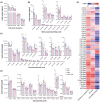rTMS ameliorates depressive-like behaviors and regulates the gut microbiome and medium- and long-chain fatty acids in mice exposed to chronic unpredictable mild stress
- PMID: 37269082
- PMCID: PMC10580350
- DOI: 10.1111/cns.14287
rTMS ameliorates depressive-like behaviors and regulates the gut microbiome and medium- and long-chain fatty acids in mice exposed to chronic unpredictable mild stress
Abstract
Introduction: Repetitive transcranial magnetic stimulation (rTMS) is a clinically useful therapy for depression. However, the effects of rTMS on the metabolism of fatty acids (FAs) and the composition of gut microbiota in depression are not well established.
Methods: Mice received rTMS (15 Hz, 1.26 T) for seven consecutive days after exposure to chronic unpredictable mild stress (CUMS). The subsequent depressive-like behaviors, the composition of gut microbiota of stool samples, as well as medium- and long-chain fatty acids (MLCFAs) in the plasma, prefrontal cortex (PFC), and hippocampus (HPC) were evaluated.
Results: CUMS induced remarkable changes in gut microbiotas and fatty acids, specifically in community diversity of gut microbiotas and PUFAs in the brain. 15 Hz rTMS treatment alleviates depressive-like behaviors and partially normalized CUMS induced alterations of microbiotas and MLCFAs, especially the abundance of Cyanobacteria, Actinobacteriota, and levels of polyunsaturated fatty acids (PUFAs) in the hippocampus and PFC.
Conclusion: These findings revealed that the modulation of gut microbiotas and PUFAs metabolism might partly contribute to the antidepressant effect of rTMS.
Keywords: CUMS; gut microbiota; medium- and long-chain fatty acids; rTMS.
© 2023 The Authors. CNS Neuroscience & Therapeutics published by John Wiley & Sons Ltd.
Conflict of interest statement
The authors have no conflicts of interest to declare.
Figures







Similar articles
-
Low-frequency Transcranial Magnetic Stimulation Ameliorates Anhedonic Behaviors and Regulates the Gut Microbiome in Mice Exposed to Chronic Unpredictable Mild Stress.Alpha Psychiatry. 2024 Aug 1;25(4):493-501. doi: 10.5152/alphapsychiatry.2024.241561. eCollection 2024 Aug. Alpha Psychiatry. 2024. PMID: 39360304 Free PMC article.
-
Chronic repetitive transcranial magnetic stimulation enhances GABAergic and cholinergic metabolism in chronic unpredictable mild stress rat model: ¹H-NMR spectroscopy study at 11.7T.Neurosci Lett. 2014 Jun 20;572:32-7. doi: 10.1016/j.neulet.2014.04.033. Epub 2014 May 4. Neurosci Lett. 2014. PMID: 24796814
-
The impact of repetitive transcranial magnetic stimulation and fluoxetine on the brain lipidome in a rat model of chronic unpredictable stress.Prog Neuropsychopharmacol Biol Psychiatry. 2020 Aug 30;102:109946. doi: 10.1016/j.pnpbp.2020.109946. Epub 2020 Apr 20. Prog Neuropsychopharmacol Biol Psychiatry. 2020. PMID: 32325156
-
Repetitive transcranial magnetic stimulation and fluoxetine attenuate astroglial activation and benefit behaviours in a chronic unpredictable mild stress mouse model of depression.World J Biol Psychiatry. 2024 Feb;25(2):82-94. doi: 10.1080/15622975.2023.2279958. Epub 2024 Jan 31. World J Biol Psychiatry. 2024. PMID: 37942712
-
Repetitive transcranial magnetic stimulation exerts anti-inflammatory effects via modulating glial activation in mice with chronic unpredictable mild stress-induced depression.Int Immunopharmacol. 2022 Aug;109:108788. doi: 10.1016/j.intimp.2022.108788. Epub 2022 Apr 30. Int Immunopharmacol. 2022. PMID: 35504201
Cited by
-
Low-frequency Transcranial Magnetic Stimulation Ameliorates Anhedonic Behaviors and Regulates the Gut Microbiome in Mice Exposed to Chronic Unpredictable Mild Stress.Alpha Psychiatry. 2024 Aug 1;25(4):493-501. doi: 10.5152/alphapsychiatry.2024.241561. eCollection 2024 Aug. Alpha Psychiatry. 2024. PMID: 39360304 Free PMC article.
-
The effects of venlafaxine on depressive-like behaviors and gut microbiome in cuprizone-treated mice.Front Psychiatry. 2024 Jun 3;15:1347867. doi: 10.3389/fpsyt.2024.1347867. eCollection 2024. Front Psychiatry. 2024. PMID: 38899045 Free PMC article.
-
Recent Progress in Mass Spectrometry-Based Metabolomics in Major Depressive Disorder Research.Molecules. 2023 Nov 4;28(21):7430. doi: 10.3390/molecules28217430. Molecules. 2023. PMID: 37959849 Free PMC article. Review.
-
The impact of electroacupuncture on anxiety-like behavior and gut microbiome in a mouse model of chronic restraint stress.Front Behav Neurosci. 2023 Nov 16;17:1292835. doi: 10.3389/fnbeh.2023.1292835. eCollection 2023. Front Behav Neurosci. 2023. PMID: 38033481 Free PMC article.
References
-
- Malhi GS, Mann JJ. Depression. Lancet. 2018;392(10161):2299‐2312. - PubMed
-
- Locher C, Koechlin H, Zion SR, et al. Efficacy and safety of selective serotonin reuptake inhibitors, serotonin‐norepinephrine reuptake inhibitors, and placebo for common psychiatric disorders among children and adolescents: a systematic review and meta‐analysis. JAMA Psychiat. 2017;74(10):1011‐1020. - PMC - PubMed
-
- Pu Y, Tan Y, Qu Y, et al. A role of the subdiaphragmatic vagus nerve in depression‐like phenotypes in mice after fecal microbiota transplantation from Chrna7 knock‐out mice with depression‐like phenotypes. Brain Behav Immun. 2021;94:318‐326. - PubMed
Publication types
MeSH terms
Substances
LinkOut - more resources
Full Text Sources
Research Materials
Miscellaneous

